篇幅有限
完整内容及源码关注公众号:ReverseCode,发送 冲
目标
http://www.gsxt.gov.cn/corp-query-entprise-info-xxgg-100000.html
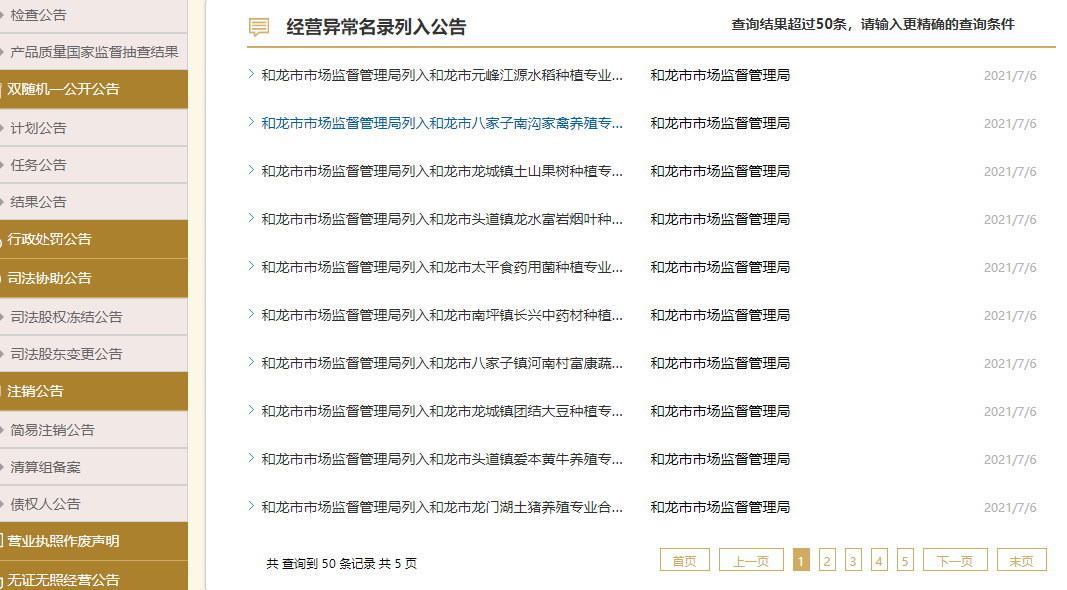
分析
- 参数:
- noticeType=21 通知类型, 失信企业固定21
- areaid=100000 无论在哪个区域, 固定是
100000 - noticeTitle= 通知标题, 可以为空
- regOrg= 通知的区域id, 可以从省份标签上获取
- 请求体数据:
- draw: 1 点击分页按钮的次数, 可以省略
- start: 0 起始索引号
- length: 10 长度, 固定是10, 设置多了也无效
直接访问该接口时,状态521,返回如下js混淆加密代码。

尝试给请求头中加上cookie__jsluid_h=f6db0fc02adff8425bebcd8ed1b5fffc; SECTOKEN=7445298838033400749; __jsl_clearance=1619443187.64|0|nGqWRKwajO%2BeHI6CP7Mt50EbdcU%3D;,正常返回如下结果。
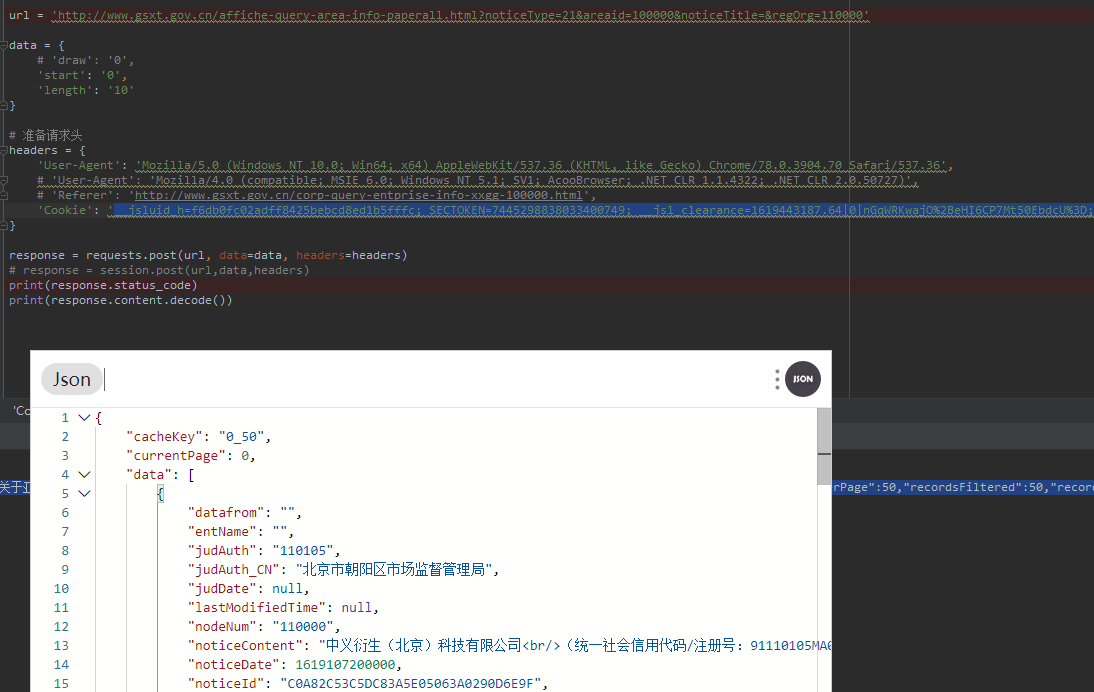
__jsluid_h
打开fiddler,刷新页面抓包http://www.gsxt.gov.cn/corp-query-entprise-info-xxgg-100000.html,一共访问了三次该页面,前两次521第三次正场返回请求页面。

第一次请求时服务端向服务器塞入第一个__jsluid_h关键cookie
1 | Set-Cookie: __jsluid_h=01737b0139a221e260d1061c68b4232f; max-age=31536000; path=/; HttpOnly |
并向浏览器返回一段混淆过的js,内容如下,主要功能应该是设置cookie。
1 | <script>document.cookie=('_')+('_')+('j')+('s')+('l')+('_')+('c')+('l')+('e')+('a')+('r')+('a')+('n')+('c')+('e')+('=')+((+true)+'')+((1+[2])/[2]+'')+(-~false+'')+(3+6+'')+(2+2+'')+(-~[2]+'')+(~~false+'')+((2)*[4]+'')+((1+[0])/[2]+'')+(9-1*2+'')+('.')+((2)*[2]+'')+(6+'')+(1+6+'')+('|')+('-')+(-~0+'')+('|')+('w')+('Y')+('p')+('A')+('F')+('R')+('%')+(1+1+'')+('B')+(-~(4)+'')+('X')+('x')+('m')+('W')+('Y')+((1<<2)+'')+('j')+('P')+('a')+('Q')+([3]*(3)+'')+('t')+('Q')+(1+7+'')+('T')+('P')+('Z')+('i')+('E')+('%')+(3+'')+('D')+(';')+('m')+('a')+('x')+('-')+('a')+('g')+('e')+('=')+(3+'')+(3+3+'')+(~~''+'')+(~~false+'')+(';')+('p')+('a')+('t')+('h')+('=')+('/');location.href=location.pathname+location.search</script> |
我们将这段js放入浏览器中执行,如我们所料,正是返回第二个__jsl_clearance关键性cookie。

__jsl_clearance
第二次请求http://www.gsxt.gov.cn/corp-query-entprise-info-xxgg-100000.html时,浏览器发送了__jsl_clearance和__jsluid_h两个关键cookie,服务端接收后并返回了一段混淆后的js,这次没有向浏览器塞入cookie。
1 | Cookie: __jsluid_h=01737b0139a221e260d1061c68b4232f; __jsl_clearance=1619430857.467|-1|wYpAFR%2B5XxmWY4jPaQ9tQ8TPZiE%3D |

SECTOKEN
第三次请求http://www.gsxt.gov.cn/corp-query-entprise-info-xxgg-100000.html时,浏览器携带了两个关键性Cookie,不过这次__jsl_clearance和之前的值发生变化,怀疑是第二次请求返回的js做了手脚。
1 | Cookie: __jsluid_h=01737b0139a221e260d1061c68b4232f; __jsl_clearance=1619430857.529|0|WGn9gKxiPtYUHAGBZ1a%2B%2F3o9sJE%3D |
这次请求不仅正常的返回了页面内容,而且还往请求头中塞入了第三个SECTOKEN关键性Cookie。
1 | Set-Cookie: SECTOKEN=7448433543385710812; Expires=Sat, 14-May-2089 13:03:34 GMT; Path=/; HttpOnly |
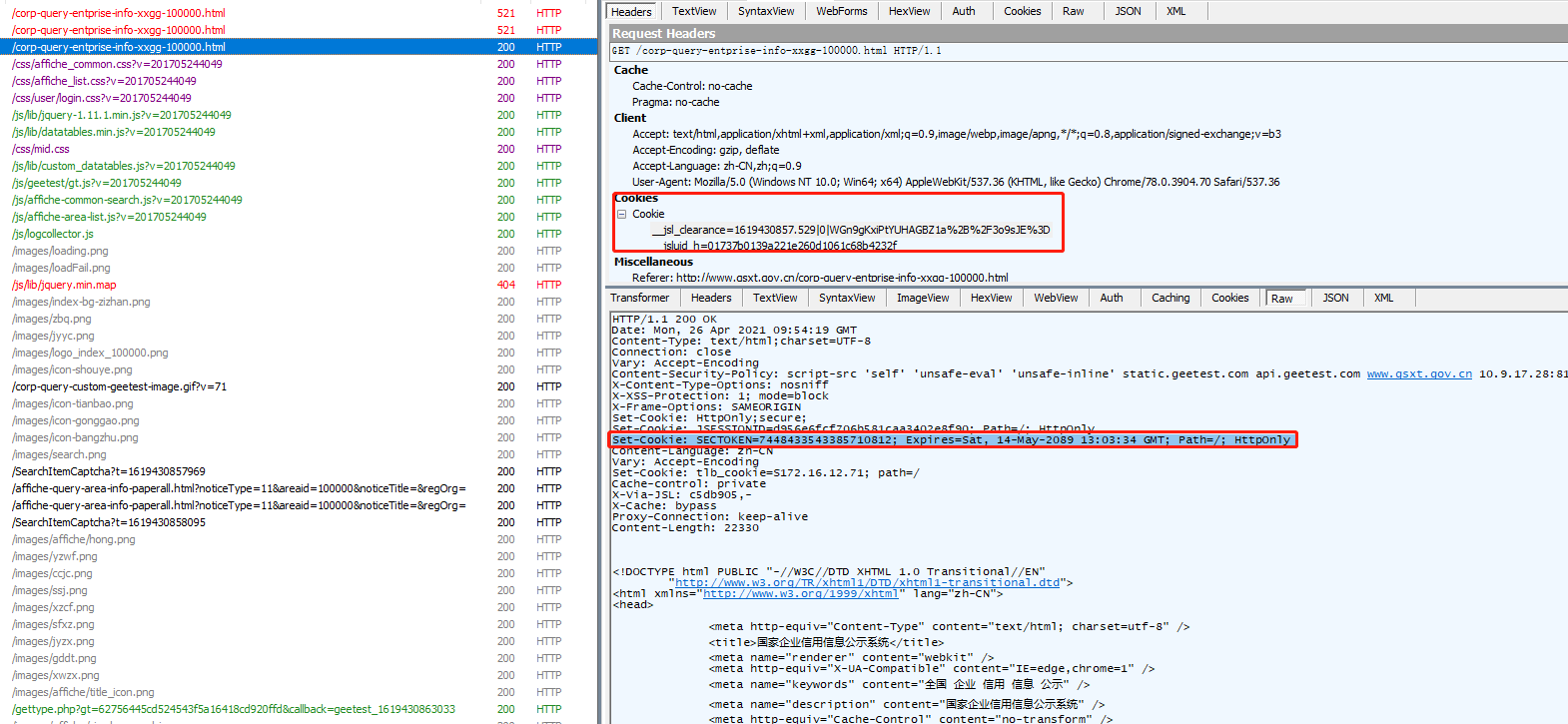
请求数据
在上面的三个cookie加持下,终于成功的返回了我们想要的数据,接下来就是分析这三个cookie在代码中如何拿到。

爬虫实现
通过requests的session对象,自动合并cookie信息,并设置请求头。
1 | headers = { |
第一次请求
通过第一次请求,服务端往客户端返回__jsluid_h作为第一个关键cookie,根据返回的js通过正则表达式拿到script标签中的js逻辑,并去除后面无用jslocation.href...
1 | response = session.get(index_url) |
第二次请求
第二次请求携带了前面两个关键性cookie,并返回了一段js。这里我们的cookie都存在了session中,所以不用额外处理。通过正则取出第二次返回的js中script标签中的内容。
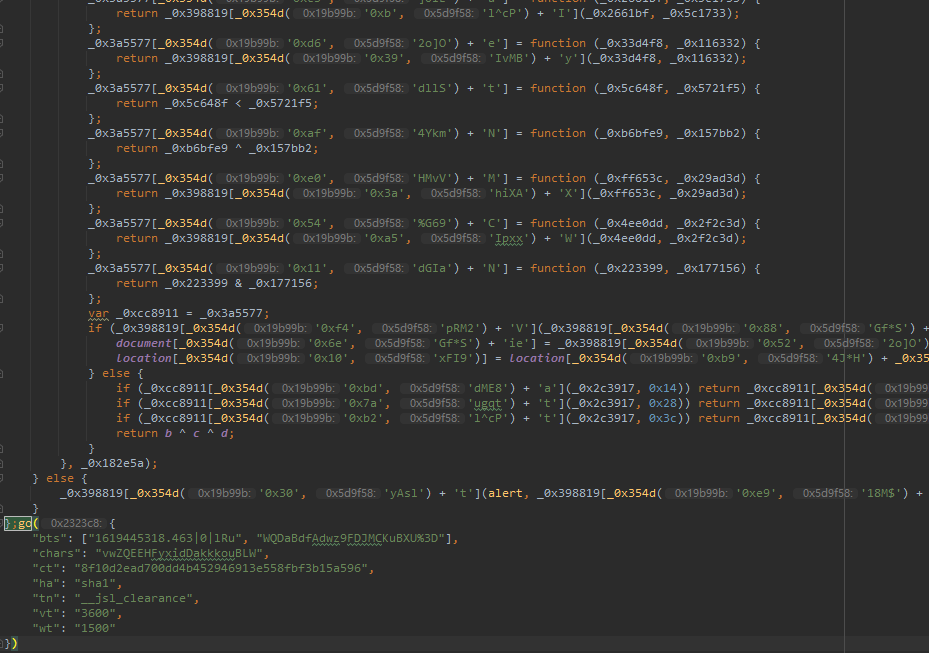
就算格式化后这段代码都难以阅读,我们通过ob混淆专解测试版V0.1进行反混淆,重新审视这段js。
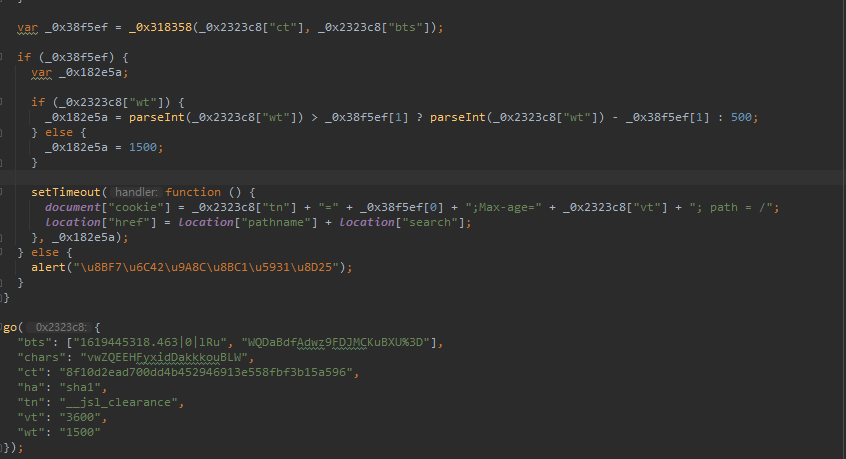
逻辑就是通过调用go函数往document中塞入cookie,我们在function go(_0x2323c8)最后返回document['cookie'],把setTimeout的时间设置久一点。

通过上面分析我们可以通过第二次请求返回的js进行修改后,python调用生成cookie传递后被修改的__jsl_clearance关键cookie。不过很多对象在python调用时不可用,如window,document,location等等,我们可以通过jsdom库npm install jsdom实现浏览器的上下文。
1 | const jsdom = require("jsdom"); |
就这段js存入文件后,python读取文件,使用execjs实现调用,返回第二个__jsl_clearance关键性cookie,为获取SECTOKEN埋下伏笔。
1 | with open(r'第二次请求.js', encoding='utf-8', mode='r') as f: |
在python中为了调用go函数,还需要在js中新创建一个request函数,让go函数的数据返回给python作为cookie存入session中。
1 | # 添加jsdom实现浏览器上下文 |
第三次请求
利用新的__jsl_clearance和__jsluid_h发送第三次请求,服务端会向客户端返回新Cookie SECTOKEN,接下来我们打印出所有的cookie。
1 | session.get(index_url) |
1 | { |
数据抓取
1 | url = 'http://www.gsxt.gov.cn/affiche-query-area-info-paperall.html?noticeType=21&areaid=100000¬iceTitle=®Org=110000' |
完整源码请关注微信公众号:ReverseCode,回复:JS逆向

